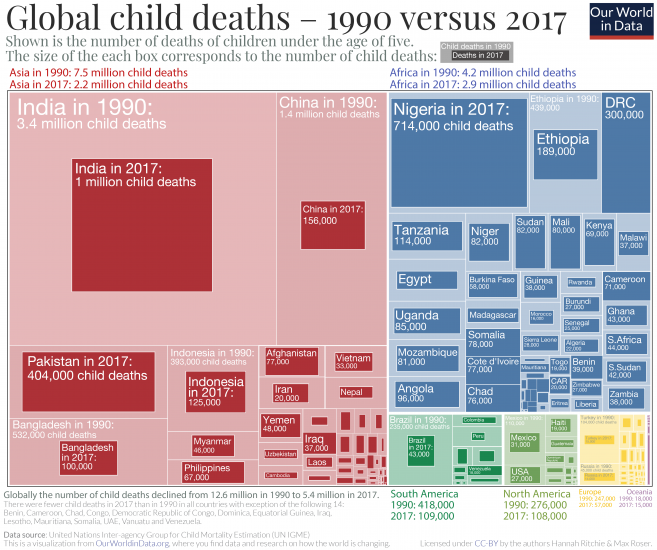5.4 million children under five years old died in 2017. The fact that in those countries with the best health, child mortality rates are 10-times lower than the global average suggests that most of these child deaths are preventable.
To reduce the number of children dying we need to know two things: where they’re dying and what they’re dying from. Here we take a look at the first question: where in the world are children dying?
We mapped the global distribution of child deaths in the somewhat unusual visualization. This type of visualization is called a treemap. Each rectangle’s size corresponds to the number of child deaths in a particular region.
The treemap shows the distribution of child deaths in 1990 and 2017:
- The number of child deaths declined in all but 14 countries from 1990 to 2017: for these countries, the outer box represents 1990 and inner box marks 2017.
- There are 14 countries where the number of child deaths increased: in this case only a single box is shown, representing deaths in 2017.1
At a time during which the number of births increased globally, the number of child deaths fell. In 1990, 12.6 million under-5s died; this more than halved to 5.4 million until 2017. Every world region also saw a decline.
Some countries have achieved a dramatic reduction:
- In India, the number of child deaths fell from 3.4 million to one million;
- In China it fell nine-fold from 1.4 million to less than 160,000;
- In Bangladesh more than five-fold from over 500,000 to 100,000;
- In Ethiopia from 439,000 to 189,000;
- And in Brazil from 235,000 to 43,000.2
But, some of the countries which have seen the greatest progress are still those where most children are dying today. India has suffered the most child deaths: one million in 2017. This was followed by Nigeria (714,000); Pakistan (400,000); the Democratic Republic of Congo (300,000); Ethiopia (189,000); and China (156,000).
The total number of children dying depends on two factors: the likelihood a newborn will die in the first years of life and the number of children born. Countries where the most children die are not necessarily those where a child’s chances of dying are highest. Here is the map of the mortality rate of children. India has a child mortality rate of around 4% – the same as the global average – and three times lower than some of the highest countries in the world. But it has, by far, the largest number of children under five years old.
This matters for the possibility to make progress in the future. India – for example – doesn’t only have a falling child mortality rate, but has also passed ‘peak child’. The number of children under five years old has already peaked and is now falling: in the coming decades, its under-5 population will decline. Fewer children and a lower likelihood of child mortality means we’d expect the total number of children dying in India to fall quickly.
Our concern will then turn towards countries where the chances of child mortality is high, and the number of births increasing. Countries where children are most likely to die – Somalia, Chad, Central African Republic, Sierra Leone, Nigeria, and Mali – will all have an increasing number of children in the coming decades. Progress on reducing child deaths will here therefore become a race between declining child mortality rates and an increasing number of children.
But the two runners in the race are not independent: one of the reasons couples have many children is because they do – or expect to – lose some of them early in life. Our progress on reducing child deaths can therefore be amplified if falling child mortality leads to falling fertility rates.
We know that most child deaths today are preventable. They result from causes we know we can tackle. How do we know this? Because we already averted many millions of child deaths in the past few decades. Between 1990 and 2017 the number of children dying each year fell by 7.2 million. By stopping those we know are preventable, we could save at least another 5 million children every year. We can reach a world with many fewer child deaths than ever before.
